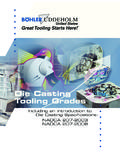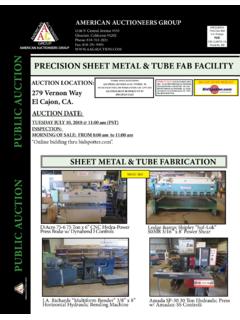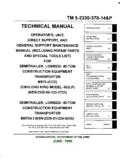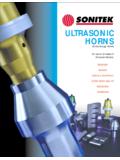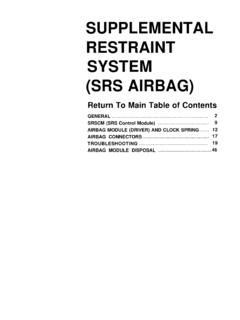Transcription of WELDING IN TOOL MAKING - bucorp.com
1 WELDING IN tool MAKINGA guideline for WELDING of cold work steels, hot work steels, high speed steels, plastic mould steels including PM steels WELDING IN tool MAKING 23 MATERIALS IN tool MAKINGI ntroductionTools often need to be welded. This is especially true for expensive tools such as die-casting dies, large forging dies, plastic moulds, car body dies and cut-ting and forming tools where repair and adjustment via WELDING is a highly cost-attractive and economic alternative to the expense of producing new tools. WELDING of tools may be required for the following reasons: Refurbishment and repair of cracked or worn tools Renovation of worn or chipped cutting edges, on cutting tools Adjustment of machining errors Design weldability of steels with high carbon content is usually considered to be poor. tool steels with carbon are difficult to weld due, for instance, to their alloying elements.
2 The main problem in WELDING tool steel stems from its high hardenability. Thermal stresses concurrent with microstructure transformation occur during the cooling of the weld. This transformation may generate cracks in the welded area. Such reductions in the weld s properties should be avoided if welds are to comply with quality brochure mainly gives technological directions on WELDING equipment, WELDING consumables, WELDING technique, heat treatment and subsequent thermal treatments that are required in order to weld tool steels and plastic mould steels successfully. We also give WELDING recommendations concerning materials in connection with UTP weld consumables for the performance of repair welds and adjustments in tool 3 Materials in tool MAKING 3 WELDING methods in tool MAKING 4 WELDING methods used 5 Manual arc WELDING TIG WELDING MIG/MAG WELDING and flux cored arc WELDING WELDING guidelines in tool MAKING 8 A selection of weld consumables Preparation prior to WELDING Working temperature before and during WELDING How to perform the WELDING Heat treatment after weldingPractice oriented WELDING test with various 14different B HLER High Performance steelsWelding recommendations concerning materials 17 WELDING of cold work steels and high speed steels 18 WELDING of hot work steels 20 WELDING of plastic mould steels 22 This brochure
3 Was written in cooperation with UTP Schwei material Schwei material GmbHEls sser Stra e 10D-79189 Bad KrozingenPhone: +49 - (0) 7633 - 409 - 01 Fax: +49 - (0) 7633 - 409 - 222 WELDING IN tool MAKING 4 tool steels are ferrous materials which are suitable for hardening. Hardening mechanisms generally stem from transformation hardening martensite formation and partly from precipitation hardening by the formation of carbides and nitrides. Cooling rate required to achieve a specific hardness is shown in time-temperature-transformation graphs. tool steels have high hardness, high wear resistance and toughness which all comply with their specific application. tool MAKING mainly uses tool steels which can be divided into cold work steels, hot work steels, high speed steels and plastic mould steels according to DIN EN ISO 4957 steelsCold work steels are unalloyed or alloyed steels used in applications with a general surface temperature below approximately 200 C.
4 Hot work steels are alloyed steels for applications with a general tool surface temperature above 200 C when in service. High speed steels have the highest hot hardness and tempering resistance due to their chemical composition and are, therefore, used at temperatures up to 600 C (they are mainly used in machining and forming). Plastic mould steels are used in the manufacturing of forming and shaping tools in plastic processing. The preferred steels here are unalloyed steels, case-hardened steels or tool steels. Plastic mould steels excel in two cate-gories: They ensure the highest steel quality and their steel properties can be adjusted individually and ideally to the different requirements of the tool and the plastic product in question. Plastic mould steels satisfy the highest requirements as regards degree of purity, polishability, uniform hardness and microstructure, wear resistance, temperature resistance, machinability, toughness and hardness and not to forget thermal conductivity and corrosion METHODS IN tool MAKINGMore then 50 different electrodes are available for the repair of tools.
5 Rutile (Ti-oxide) electrodes or basic coated electrodes are made use of depending on the requirements. Rutile coated electrodes have a stable and soft spray arc and enable WELDING with low amperage. The resulting even WELDING bead is ideal for the WELDING of cutting edges. The slag comes off on its own. Mechanical weld quality ranges from good to very good. But note that the mechanical weld quality will not reach that of a basic coated electrode. WELDING methods usedManual arc weldingAn electric arc is struck between a coated electrode and the workpiece. Conta-mination by air during the transfer of molten drops from electrode to workpiece in the weld pool, and during solidification of the weld pool, is inhibited by slag and by inert gas created during melting of the electrode. The composition of the weld metal deposit is controlled via the composition of the consumables in the bead wire and in the electrode coating.
6 For manual electric arc WELDING , it is possible to use either an AC or a DC generator. However, which ever is used, the generator must provide a voltage and current which is compatible with the chosen electrode. Basic coated electrodes have a more intense arc, stronger arcing and higher coating. Welds do not appear as finely flaked as with rutile coated electrodes. The slag needs not be removed at multi-run WELDING , which is an advantage when larger WELDING jobs are performed. Weld metal deposit having superior toughness can achieve hydrogen contents of < 5 of manual arc weldingTransformerWelding transducerWelding transformerWelding commutatorVDE 0544 (EN 60974)}Work part connection(because of wind adjustable in position)Electric arc(standardized working voltage)Secondary inductorRod holderVDE 0544-201 WELDING rod(EN 499) WELDING IN tool MAKING 6 TIG weldingIn TIG WELDING , the arc is initially struck by subjecting the tungsten electrode and the workpiece under an inert-gas coating (argon) to a high-frequency voltage.
7 The resulting ionization of the gas between electrode and workpiece means contact is unnecessary between electrode and workpiece. TIG WELDING can be performed with a regular electric arc WELDING power generator provided it is complemented with a TIG control unit. The tungsten electrode is always connected to the negative terminal of a DC generator in order to minimize heat generation and thereby any risk of melting the elec-trode. WELDING is facilitated if the current can be increased progressively from zero to the optimum level. The unit should have a foot switch with which current can be reduced and controlled exactly. The inert-gas should be argon with a purity of vol%. The WELDING rod, a necessary weld consumable, is moved in the arc at an angle and is consumed during WELDING without any flow of current. Oxidation of the weld metal deposit is prevented by an inert-gas coating. TIG WELDING is particularly applied in repairs of small tools.
8 It is advantageous when complicated cutting edges and dies are to be repaired. If small tung-sten electrodes are used, heat can accumulate better. And weld metal can be deposited better without influencing the basic steel too much as regards heat and minimizing of TIG weldingWelding equipment and WELDING processProtective gas bottle with pressure-reducing regulator and measurement for amount of gasWelding current line ( WELDING electrode) WELDING current line (work piece)Power supplyWork piece clampWelding burnerProtective gas hoseWelding equipment for TIG- WELDING consists of current source with protective gas bottle hoses WELDING burnerAdditional an automatical auxiliary wire feeding can be WELDING rodClamp sleeve and current lineProtective gas casingWelding rodLiquid WELDING metalElectric arc7 MIG/MAG WELDING and flux cored arc weldingAn endless and mostly positive wire electrode is fed via a wire feeder to the arc and melted under inert-gas (MIG) or active gas (MAG).
9 The power source has a flat load curve and specific WELDING properties. Different arcs ban be MIG/MAG WELDING is widely used in economic WELDING of large volumes of weld metal in the metal processing industry. Typical applications in tool MAKING are the following: armoring of large shearing knives made of unallo-yed steels, flux cored WELDING of forging dies or shaping thereof and build-up WELDING of rolls. Flux cored electrodes are simple a metal tube with WELDING powder. Follow-ing their fillers, flux cored electrodes are divided into rutile, basic and metal formed by changing the amperage of the power source. The table below gives an overview of properties and informs on applications of different arcs. In general, wires of mm or mm are electrodes. Gas-shielded flux cored wires need an inert-gas shielding having the same quality than solid core electrodes. Self-protective flux cored electrodes have a core with a high content of gas-forming substances (MF procedure).
10 A free wiretail of at least 20 mm is necessary so that a sufficient amount of shielding gas can generate. This MF procedure is a big advantage at construction sites because no special shielding is needed in WELDING . Such wires are more frequently made use of in build-up of MIG/MAG weldingElectric arcs in conventional MIG/MAG weldingElectric arcApplicationMaterial transitionSpatteringRemarksMIG/MAG dip-transfer arcMIG/MAG intermediate arc MIG/MAG spray arcMAG long arcMIG/MAG impulse arcthin sheets, out-of-position welds, root weldingmedium sheet thickness, out-of-position weldsmedium and high sheet thickness in position PA, PBmedium and high sheet thickness in position PA, PBlarge working areain short circuit, with thick dropletsmaterial transitionpartly in short circuitmaterial transition with thin droplets and without any short circuitsmaterial transitionpartly in short circuitwithout shortening, 1 droplet per impulselow, with appropriate power sourcepartly spatter-prone on workpiece lowpartly spatter-prone on workpiece very lowlow heat input.
